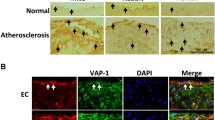Abstract
Although the existence of plasma and tissue-bound semicarbazide-sensitive amine oxidases (SSAOs) has been recognised for a long time, the physiological relevance of these enzymes still remains uncertain. The ability of SSAO to metabolise various aliphatic and aromatic monoamines differs between species, which limits the predictive value of the animal studies for human tissues. SSAO plays a protective role because the oxidative deamination of monoamines reduces their pharmacological activities. However, the products of deamination may be toxic. Several observations indicated that the plasma and tissue SSAO activities differ in certain disease states. It is proposed that selective inhibitors, of low toxicity, might be protective, through inhibiting the formation of the toxic products and the countering the disease-related elevation of SSAO activity. We reported earlier that there was a significant correlation between the serum SSAO activity and severity of atherosclerosis, as well as the intima-media thickness and serum cholesterol levels. Thus SSAO activity might be a clinical marker in the prognostic evaluation of diabetic-vascular complications. Although molecular biological studies are providing more and more reliable knowledge about the enzyme structure, many more studies should be carried out in different disease states are necessary to discover the clinical meaning of the enzyme function.
Similar content being viewed by others
REFERENCES
Boomsma, F., van den Meiracker, A., Man in 't Veld, A., et al. (1995). Contrasting effects of peripheral decarboxylase inhibitors on plasma activity of aromatic-L-amino acid decarboxylase and emicarbazide-sensitiveamine oxidase in Parkinson's disease, Life Sci. 57, 1753–1759.
Boomsma, F., van Veldhuisen, D. J., de Kam, P. J., et al. (1997). Plasma semicarbazide-sensitive amine oxidase is elevated in patients with congestive heart failure, Cardiovasc. Res. 33, 387–391.
Bradford, M. M. (1976). A rapid and sensitive method for the quantitation of microgram quantities of protein utilising the principle of protein dye-binding, Anal. Biochem. 72, 248–254.
Callingham, B. A., Holt, A. and Elliott, J. (1990). Some aspects of the pharmacology of semicarbazide-sensitiveamine oxidases, J. Neural Transm. (Suppl.) 32, 279–290.
Deng, Y. and Yu, P. H. (1999). Simultaneous determination of formaldehyde and methylglyoxal in urine: involvement of semicarbazide-sensitive amine oxidase-mediated deamination in diabetic complications, J. Chromatogr. Sci. 37, 317–322.
Elliott, J., Callingham, B. A. and Barrand, M. A. (1989). In-vivo effects of (E)-2-(3′,4′-dimetho-xyphenyl)-3-'uoroallylamine (MDL 72145) on amine oxidase activities in the rat. Selective inhibition of semicarbazide-sensitive amine oxidase in vascular and brown adipose tissues, J. Pharm. Pharmacol. 41, 37–41.
Fitzgerald, D. H., Tipton, K. F. and Lyles, G. A. (1998). Studies on the behaviour of semicarbazide-sensitive amine oxidase in Sprague-Dawley rats treated with the monoamine oxidase inhibitor tranylcypromine. J. Neural Transm. (Suppl.) 52, 259–264.
Garpenstrand, H., Ekblom, J., von Arbin, M., et al. (1999). Plasma semicarbazide-sensitive amine oxidase in stroke, Eur. Neurol. 41, 20–23.
Garpenstrand, H., Ekblom, J., Backlund, L. B., et al. (1999). Elevated plasma semicarbazide-sensitive amine oxidase (SSAO) activity in Type 2 diabetes mellitus complicated by retinopathy, Diabet. Med. 16, 514–521.
Guffroy, C. and Strolin Benedetti, M. (1984). Monoamine oxidase and semicarbazide-sensitiveamine oxidase in spontaneously hypertensive and in normotensive control rats, Life Sci. 34, 535–545.
Lizcano, J. M., Balsa, D., Tipton, K. F., et al. (1991). The oxidation of dopamine by the semicarbazide-sensitive amine oxidase (SSAO) from rat vas deferens, Biochem. Pharmacol. 41, 1107–1110.
Lyles, G. A. (1994). Properties of mammalian tissue-bound semicarbazide-sensitive amine oxidase: possible clues to its physiological function? J. Neural Transm. (Suppl.) 41, 387–396.
Lyles, G. A. (1996). Mammalian plasma and tissue-bound semicarbazide-sensitive amine oxidases: biochemical, pharmacological and toxicological aspects, Int. J. Biochem. Cell Biol. 28, 259–274.
Meszaros, Z., Szombathy, T., Raimondi, L., et al. (1999). Elevated serum semicarbazide-sensitive amine oxidase activity in non-insulin-dependent diabetes mellitus: correlation with body mass index and serum triglyceride, Metabolism 48, 113–117.
Palfreyman, M. G., McDonald, I. A., Bey, P., et al. (1994). Haloallylamine inhibitors of MAO and SSAO and their therapeutic potential, J. Neural Transm. (Suppl.) 41, 407–414.
Yu, P. H., Davis, B. A., Boulton, A. A., et al. (1994). Deamination of aliphatic amines by type B monoamine oxidase and semicarbazide-sensitive amine oxidase; pharmacological implications, J. Neural Transm. (Suppl.) 41, 397–406.
Yu, P. H. and Deng, Y. L. (1998). Endogenous formaldehyde as a potential factor of vulnerability of atherosclerosis: involvement of semicarbazide-sensitiveamine oxidase-mediated methylamine turnover, Atherosclerosis 140, 357–363.
Yu, P. H., Lai, C. T. and Zuo, D. M. (1997). Formation of formaldehyde from adrenaline in vivo; a potential risk factor for stress-related angiopathy, Neurochem. Res. 2B, 615–620.
Yu, P. H. and Zuo, D. M. (1997). Aminoguanidine inhibits semicarbazide-sensitive amine oxidase activity: implications for advanced glycation and diabetic complications, Diabetologia 40, 1243–1250.
Yu, P. H. and Zuo, D. M. (1993). Oxidative deamination of methylamine by semicarbazide-sensitive amine oxidase leads to cytotoxic damage in endothelial cells. Possible consequences for diabetes, Diabetes 42, 594–603.
Zuo, D. M. and Yu, P. H. (1994). Semicarbazide-sensitive amine oxidase and monoamine oxidase in rat brain microvessels, meninges, retina and eye sclera, Brain Res. Bull. 33, 307–311.
Rights and permissions
About this article
Cite this article
Magyar, K., Mészáros, Z. Semicarbazide-sensitive amine oxidase (SSAO): present and future. Inflammopharmacology 11, 165–173 (2003). https://doi.org/10.1163/156856003765764335
Issue Date:
DOI: https://doi.org/10.1163/156856003765764335




